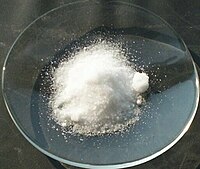
Photo from wikipedia
Abstract Salt marshes play an important role in removing excess nitrogen through microbial processes such as denitrification and anaerobic ammonia oxidation (anammox), and one of the major factors known to… Click to show full abstract
Abstract Salt marshes play an important role in removing excess nitrogen through microbial processes such as denitrification and anaerobic ammonia oxidation (anammox), and one of the major factors known to influence the nitrogen purification capacity of salt marshes worldwide is the invasion of alien species. Previous studies on the effects of invasive plants on nitrogen removal have tended to focus on the upper soils, whereas only a few have sought to examine the effects of exotic species on nitrogen removal in deep soils. This disparity may thus have led to unrepresentative evaluations when attempting to make integrated assessments of the ecosystem services provided by exotic species. Here, using the 15N tracer technique, we investigated the processes of denitrification and anammox in sediments of four habitat types (bare mudflat and marshlands dominated by the native plant species Scirpus mariqueter and Phragmites australis and the invasive plant Spartina alterniflora) on Chongming Island, located in the Yangtze River Estuary, China. Measurements were taken in May and October 2018 from six different depth ranges (0–5, 5–10, 10–20, 20–30, 30–50, and 50–100 cm) within the soil profile. With respect to the entire soil profile, we found that S. alterniflora did not facilitate effective nitrogen removal compared with the native plants S. mariqueter and P. australis. However, S. alterniflora did significantly increase nitrogen removal in the upper 50 cm of soil, whereas a slight reduction in nitrogen removal was observed in the deeper 50–100 cm soil layer. These results indicate that nitrogen removal was significantly increased only in the upper soils subsequent to S. alterniflora invasion, which contributes to our existing knowledge regarding the effects of invasive species on the nitrogen cycle in salt marshes. Furthermore, we established that in the upper soil layers between 0 and 50 cm, denitrification is primarily regulated by NO3- and the C/N ratio, whereas anammox is predominantly regulated by bulk density. Contrastingly, in the deeper soil layers between 50 and 100 cm, both these processes are largely regulated by redox potential and pH. These results serve to highlight that when evaluating the ecosystem services provided by S. alterniflora in salt marshes, it is necessary to estimate nitrogen removal in both the upper and deeper soil layers.
Journal Title: Journal of Cleaner Production
Year Published: 2020
Link to full text (if available)
Share on Social Media: Sign Up to like & get
recommendations!